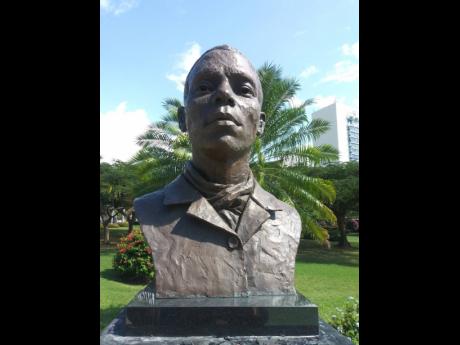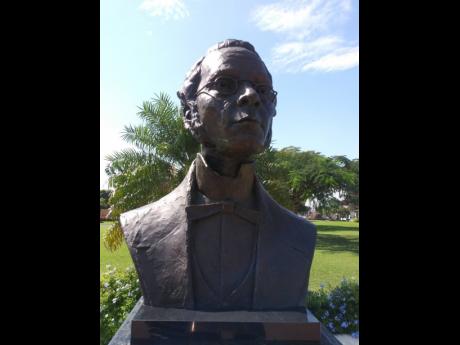Bogle and Gordon changed the government indirectly
PAUL BOGLE was born James Bogle. He was called Paul after he became a deacon in the native Baptist Church. He fathered at least three children – William, Richard and Cecelia.
He was a small cane farmer and businessman who owned horses. Along with his brother and nephew, he was also a baker. This independent peasant was one of only 106 inhabitants in the parish who had the right to vote.
There were many social justice issues in St Thomas at the time, and thus Bogle evolved into a social justice activist, the leader of a passive resistance to oppression and injustice. When the passivity failed, he led protest marches, which included the one from Stony Gut in St Thomas to Spanish Town in St Catherine to see Governor Eyre, who refused to entertain him.
He was the political agent of George William Gordon, a brown well-to-do landowning politician, with whom he had religious ties. Bogle not only organised the people of Stony Gut in religious activities, but also in military training. He was frustrated by the injustice meted out to the people, and there were cries for justice, which the authorities ignored.
Things came to a head on Saturday, October 7, 1865, when Deacon Paul Bogle and his followers, armed with bludgeons and accompanied by music, attended the trial of a black man from Stony Gut who was arrested because he trespassed on a long-abandoned estate.
But, another peasant from Stony Gut was arrested because he spoke out in court against the unjust arrest. Bogle and the others attempted to rescue the man, and a melee occurred. The man was rescued and the police severely beaten, after which Bogle et al retreated to Stony Gut.
On Monday, the 9th, six policemen went to Stony Gut with warrants to arrest 28 peasants. When they arrived, conch shells were blown, and a mob with guns, cutlasses, pikes and bayonets appeared. Three policemen were beaten, handcuffed and forced to take an oath to abandon the whites and join the blacks.
Custos Baron von Keteldodt was out of parish. He returned to the parish the following day at noon. He wrote a letter to Governor John Eyre apprising him of the incident of October 7. There were talks that Bogle and his followers would return to Morant Bay.
They had sent a petition to the governor asking for protection from the police because they were “Her Majesty’s loyal subjects”. They said if protection was refused “we will be compelled to put our shoulders to the wheel”.
Fearing another disturbance, Governor Eyre sent 100 troops from Kingston to Morant Bay by ship, and instructed Custos Ketelhodt by way of letter. With that done, Governor Eyre set off to Flamstead, his mountain retreat, for a dinner party to be held the following day.
The parish was filled with tension, as more disturbances were anticipated. And on Wednesday, October 11, Bogle and his followers marched from Stony Gut to Morant Bay where the vestry was meeting in the courthouse.
A confrontation with the authorities ensued. Many people, including Custos Baron von Keteldodt, were killed and the courthouse gutted by fire. Over 400 protesters were killed in the aftermath by the authorities. Bogle himself was hanged on October 25 for his role in the uprising. He was conferred with the title of National Hero in 1969.
George William Gordon of St Thomas-In-The-East was born to a slave mother and a father who was a plantation owner, who was a lawyer to several sugar estates in Jamaica. He was self-educated and became a landowner in St Thomas.
Gordon was unhappy with the lot of the grassroot people in the parish. Yet, the people whom he represented could not vote. He urged them to protest against the conditions under which they were forced to live. As a member of the Local Assembly, he was the mouthpiece for the oppressed. He was a great associate of parishioner Paul Bogle whom he ordained deacon.
However, Gordon was not a participant in Bogle’s march from Stony Gut to Morant Bay, and was not even in the parish when the 1865 Morant Bay Uprising took place. He was transported from Kingston to St Thomas by ship on Governor Eyre’s instructions, and was illegally court martialed.
Despite the lack of evidence against him, Gordon was convicted and sentenced to death. He was hanged at Morant Bay on October 23, 1865, and was conferred with the title of National Hero in 1969. The current seat of the Jamaican Parliament, George William Gordon House, was named after him.
When he led the march to Morant Bay, Paul Bogle had absolutely no idea that it was a watershed moment in Jamaica’s social and political history. The uprising marked the end of the planters’ power and led to the establishment of direct Crown rule in Jamaica. Governor Eyre was recalled, and the Jamaican Government was dissolved, with the colony brought under direct rule from the British Crown.
Following the rebellion and the subsequent Royal Commission, which found the punishments to be excessive, some reforms were implemented. These included improvements in infrastructure and education. The lives of many peasants were lost, but not in vain, it seems.


